 W
WA capacitor is a device that stores electrical energy in an electric field. It is a passive electronic component with two terminals.
 W
WCapacitors are manufactured in many forms, styles, lengths, girths, and from many materials. They all contain at least two electrical conductors separated by an insulating layer. Capacitors are widely used as parts of electrical circuits in many common electrical devices.
 W
WIn physiology, an action potential (AP) occurs when the membrane potential of a specific cell location rapidly rises and falls: this depolarization then causes adjacent locations to similarly depolarize. Action potentials occur in several types of animal cells, called excitable cells, which include neurons, muscle cells, endocrine cells and in some plant cells.
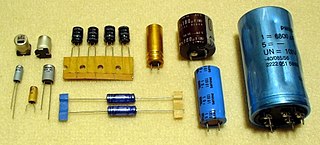 W
WAluminium capacitors are polarized electrolytic capacitors whose anode electrode (+) is made of a pure aluminum foil with an etched surface. The aluminum forms a very thin insulating layer of aluminium oxide by anodization that acts as the dielectric of the capacitor. A non-solid electrolyte covers the rough surface of the oxide layer, serving in principle as the second electrode (cathode) (-) of the capacitor. A second aluminum foil called “cathode foil” contacts the electrolyte and serves as the electrical connection to the negative terminal of the capacitor.
 W
WCapacitors have many uses in electronic and electrical systems. They are so ubiquitous that it is rare that an electrical product does not include at least one for some purpose.
 W
WA capacitor vehicle or capa vehicle is a traction vehicle that uses supercapacitors to store electricity.
 W
WCapacitive coupling is the transfer of energy within an electrical network or between distant networks by means of displacement current between circuit(s) nodes, induced by the electric field. This coupling can have an intentional or accidental effect.
 W
WThe capacitor plague was a problem related to a higher-than-expected failure rate of non-solid aluminium electrolytic capacitors, between 1999 and 2007, especially those from some Taiwanese manufacturers, due to faulty electrolyte composition that caused corrosion accompanied by gas generation, often rupturing the case of the capacitor from the build-up of pressure.
 W
WA ceramic capacitor is a fixed-value capacitor where the ceramic material acts as the dielectric. It is constructed of two or more alternating layers of ceramic and a metal layer acting as the electrodes. The composition of the ceramic material defines the electrical behavior and therefore applications. Ceramic capacitors are divided into two application classes:Class 1 ceramic capacitors offer high stability and low losses for resonant circuit applications. Class 2 ceramic capacitors offer high volumetric efficiency for buffer, by-pass, and coupling applications.
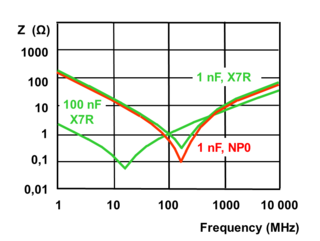 W
WA decoupling capacitor is a capacitor used to decouple one part of an electrical network (circuit) from another. Noise caused by other circuit elements is shunted through the capacitor, reducing the effect it has on the rest of the circuit. An alternative name is bypass capacitor as it is used to bypass the power supply or other high impedance component of a circuit.
 W
WA supercapacitor (SC), also called an ultracapacitor, is a high-capacity capacitor with a capacitance value much higher than other capacitors, but with lower voltage limits, that bridges the gap between electrolytic capacitors and rechargeable batteries. It typically stores 10 to 100 times more energy per unit volume or mass than electrolytic capacitors, can accept and deliver charge much faster than batteries, and tolerates many more charge and discharge cycles than rechargeable batteries.
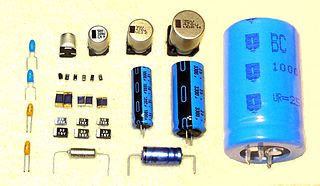 W
WAn electrolytic capacitor is a polarized capacitor whose anode or positive plate is made of a metal that forms an insulating oxide layer through anodization. This oxide layer acts as the dielectric of the capacitor. A solid, liquid, or gel electrolyte covers the surface of this oxide layer, serving as the cathode or negative plate of the capacitor. Due to their very thin dielectric oxide layer and enlarged anode surface, electrolytic capacitors have a much higher capacitance-voltage (CV) product per unit volume than ceramic capacitors or film capacitors, and so can have large capacitance values. There are three families of electrolytic capacitor: aluminum electrolytic capacitors, tantalum electrolytic capacitors, and niobium electrolytic capacitors.
 W
WAn electrophorus or electrophore is a simple manual capacitive electrostatic generator used to produce electrostatic charge via the process of electrostatic induction. A first version of it was invented in 1762 by Swedish professor Johan Carl Wilcke,. Italian scientist Alessandro Volta improved and popularized the device in 1775, and is sometimes erroneously credited with its invention. The word electrophorus was coined by Volta from the Greek ήλεκτρον ('elektron'), and ϕέρω ('phero'), meaning 'electricity bearer'.
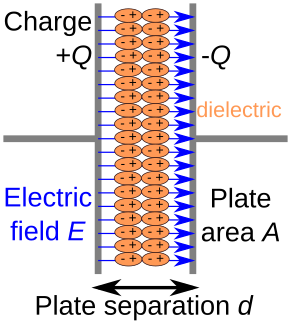 W
WFerroelectric capacitor is a capacitor based on a ferroelectric material. In contrast, traditional capacitors are based on dielectric materials. Ferroelectric devices are used in digital electronics as part of ferroelectric RAM, or in analog electronics as tunable capacitors (varactors).
 W
WFilm capacitors, plastic film capacitors, film dielectric capacitors, or polymer film capacitors, generically called "film caps" as well as power film capacitors, are electrical capacitors with an insulating plastic film as the dielectric, sometimes combined with paper as carrier of the electrodes.
 W
WCapacitors have many uses in electronic and electrical systems. They are so ubiquitous that it is rare that an electrical product does not include at least one for some purpose.
 W
WFranklin bells are an early demonstration of electric charge designed to work with a Leyden jar. Franklin bells are only a qualitative indicator of electric charge and were used for simple demonstrations rather than research. This was the first device that converted electrical energy into mechanical energy in the form of continuous mechanical motion, in this case, the moving of a bell clapper back and forth between two oppositely charged bells.
 W
WIbiden Co., Ltd. is a Japanese electronics company headquartered in Ogaki, Gifu prefecture that manufactures electronics-related products, such as printed circuit boards and IC packaging. The company also makes ceramics products, including particulate filters for diesel engines, for which it has a 50% market share in Europe.
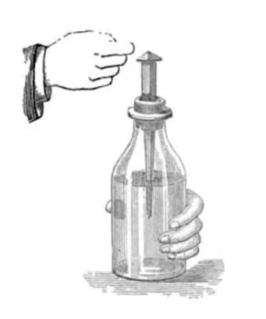 W
WA Leyden jar is an antique electrical component which stores a high-voltage electric charge between electrical conductors on the inside and outside of a glass jar. It typically consists of a glass jar with metal foil cemented to the inside and the outside surfaces, and a metal terminal projecting vertically through the jar lid to make contact with the inner foil. It was the original form of the capacitor.
 W
WA lithium-ion capacitor (LIC) is a hybrid type of capacitor classified as a type of supercapacitor. It is called a hybrid because the anode is the same as those used in lithium-ion batteries and the cathode is the same as those used in supercapacitors. Activated carbon is typically used as the cathode. The anode of the LIC consists of carbon material which is often pre-doped with lithium ions. This pre-doping process lowers the potential of the anode and allows a relatively high output voltage compared to other supercapacitors.
 W
WA MIS capacitor is a capacitor formed from a layer of metal, a layer of insulating material and a layer of semiconductor material. It gets its name from the initials of the metal-insulator-semiconductor structure. As with the MOS field-effect transistor structure, for historical reasons, this layer is also often referred to as a MOS capacitor, but this specifically refers to an oxide insulator material.
 W
WThe metal–oxide–semiconductor field-effect transistor, also known as the metal–oxide–silicon transistor, is a type of insulated-gate field-effect transistor that is fabricated by the controlled oxidation of a semiconductor, typically silicon. The voltage of the covered gate determines the electrical conductivity of the device; this ability to change conductivity with the amount of applied voltage can be used for amplifying or switching electronic signals.
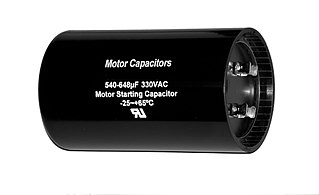 W
WA motor capacitor, such as a start capacitor or run capacitor is an electrical capacitor that alters the current to one or more windings of a single-phase alternating-current induction motor to create a rotating magnetic field.
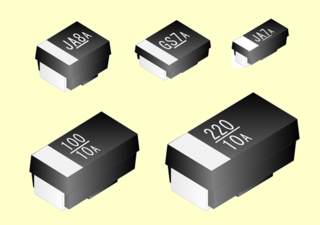 W
WA niobium electrolytic capacitor is a polarized capacitor whose anode electrode (+) is made of passivated niobium metal or niobium monoxide on which an insulating niobium pentoxide layer acts as the dielectric of the niobium capacitor. A solid electrolyte on the surface of the oxide layer serves as the second electrode (cathode) (-) of the capacitor.
 W
WA polymer capacitor, or more accurately a polymer electrolytic capacitor, is an electrolytic capacitor (e-cap) with a solid conductive polymer electrolyte. There are four different types:Polymer tantalum electrolytic capacitor Polymer aluminum electrolytic capacitor Hybrid polymer capacitor Polymer niobium electrolytic capacitors
 W
WPseudocapacitance is the electrochemical storage of electricity in an electrochemical capacitor (Pseudocapacitor). This faradaic charge transfer originates by a very fast sequence of reversible faradaic redox, electrosorption or intercalation processes on the surface of suitable electrodes. Pseudocapacitance is accompanied by an electron charge-transfer between electrolyte and electrode coming from a de-solvated and adsorbed ion. One electron per charge unit is involved. The adsorbed ion has no chemical reaction with the atoms of the electrode since only a charge-transfer takes place.
 W
WPseudocapacitors store electrical energy faradaically by electron charge transfer between electrode and electrolyte. This is accomplished through electrosorption, reduction-oxidation reactions, and intercalation processes, termed pseudocapacitance.
 W
WA Ragone plot is a plot used for comparing the energy density of various energy-storing devices. On such a chart the values of specific energy are plotted versus specific power. Both axes are logarithmic, which allows comparing performance of very different devices. Ragone plots can reveal information about gravimetric energy density, but do not convey details about volumetric energy density.
 W
WSAL electrolytic capacitors are a form of capacitor developed for high capacitance in a small package, with a long and robust service life. They are aluminum electrolytic capacitors with anodic oxidized aluminum oxide as dielectric and with the semiconducting solid manganese dioxide as electrolyte. They are made of etched and formed aluminum anodes, which are folded for the dipped pearl types or wound into a roll for the axial style. The solid manganese dioxide electrolyte is formed onto this roll in a pyrolytic process, similar to that for solid tantalum capacitors.
 W
WSilver mica capacitors are high precision, stable and reliable capacitors. They are available in small values, and are mostly used at high frequencies and in cases where low losses and low capacitor change over time is desired.
 W
WA tantalum electrolytic capacitor is an electrolytic capacitor, a passive component of electronic circuits. It consists of a pellet of porous tantalum metal as an anode, covered by an insulating oxide layer that forms the dielectric, surrounded by liquid or solid electrolyte as a cathode. Because of its very thin and relatively high permittivity dielectric layer, the tantalum capacitor distinguishes itself from other conventional and electrolytic capacitors in having high capacitance per volume and lower weight.
 W
WA trimmer is a miniature adjustable electrical component. It is meant to be set correctly when installed in some device, and never seen or adjusted by the device's user. Trimmers can be variable resistors (potentiometers), variable capacitors, or trimmable inductors. They are common in precision circuitry like A/V components, and may need to be adjusted when the equipment is serviced. Trimpots are often used to initially calibrate equipment after manufacturing. Unlike many other variable controls, trimmers are mounted directly on circuit boards, turned with a small screwdriver and rated for many fewer adjustments over their lifetime. Trimmers like trimmable inductors and trimmable capacitors are usually found in superhet radio and television receivers, in the intermediate frequency (IF), oscillator and radio frequency (RF) circuits. They are adjusted into the right position during the alignment procedure of the receiver.
 W
WThe two capacitor paradox or capacitor paradox is a paradox, or counterintuitive thought experiment, in electric circuit theory. The thought experiment is usually described as follows: Two identical capacitors are connected in parallel with an open switch between them. One of the capacitors is charged with a voltage of , the other is uncharged. When the switch is closed, some of the charge on the first capacitor flows into the second, reducing the voltage on the first and increasing the voltage on the second. When a steady state is reached and the current goes to zero, the voltage on the two capacitors must be equal since they are connected together. Since they both have the same capacitance the charge will be divided equally between the capacitors so each capacitor will have a charge of and a voltage of . At the beginning of the experiment the total initial energy in the circuit is the energy stored in the charged capacitor:
 W
WA vacuum variable capacitor is a variable capacitor which uses a high vacuum as the dielectric instead of air or other insulating material. This allows for a higher voltage rating than an air dielectric using a smaller total volume. However, many dielectrics have higher breakdown field strengths than vacuum: 60-170 MV/m for teflon, 470-670 MV/m for fused silica and 2000 MV/m for diamond, compared with 20-40 MV/m for vacuum. There are several different designs in vacuum variables. The most common form is inter-meshed concentric cylinders, which are contained within a glass or ceramic vacuum envelope, similar to an electron tube. A metal bellows is used to maintain a vacuum seal while allowing positional control for the moving parts of the capacitor.
 W
WA variable capacitor is a capacitor whose capacitance may be intentionally and repeatedly changed mechanically or electronically. Variable capacitors are often used in L/C circuits to set the resonance frequency, e.g. to tune a radio, or as a variable reactance, e.g. for impedance matching in antenna tuners.
 W
WIn electronics, a varicap diode, varactor diode, variable capacitance diode, variable reactance diode or tuning diode is a type of diode designed to exploit the voltage-dependent capacitance of a reverse-biased p–n junction.
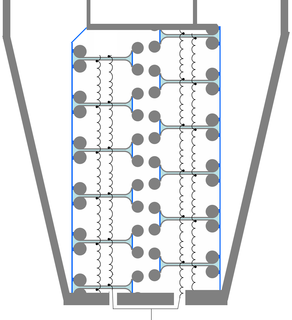 W
WA water capacitor is a device that uses water as its dielectric insulating medium.